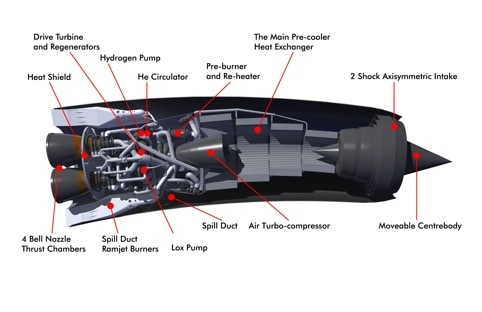The analysis was undertaken by AFRL as part of a Cooperative Research and Development Agreement (‘CRADA’) with the Air Force Research Laboratory’s Aerospace Systems Directorate (AFRL/RQ) which was entered into in January 2014. These investigations examined the thermodynamic cycle of the SABRE concept and found no significant barrier to its theoretical viability provided the engine component and integration challenges are met.
According to a statement, Oxforshire-based Reaction Engines and AFRL are now formulating plans for continued collaboration on the SABRE engine; the proposed work will include investigation of vehicle concepts based on a SABRE derived propulsion system, testing of SABRE engine components and exploration of defence applications for Reaction Engines’ heat exchanger technologies.

Barry Hellman, AFRL/RQ program manager said: “The activities under the CRADA have allowed AFRL to understand the SABRE engine concept, its pre-cooler heat exchanger technology, and its cycle in more detail. Our analysis has confirmed the feasibility and potential performance of the SABRE engine cycle.
“While development of the SABRE represents a substantial engineering challenge, the engine cycle is a very innovative approach and warrants further investigation. The question to answer next is what benefit the SABRE could bring to high-speed aerospace vehicles compared to other propulsion systems.
“Although application of the SABRE for single stage to orbit space access remains technically very risky as a first application, the SABRE may provide some unique advantages in more manageable two stage to orbit configurations. Furthermore, the heat exchanger technology also warrants further investigation for applications across the aerospace domain.”
SABRE - through the combination of unique thermodynamic cycles and Reaction Engines’ heat exchangers - can reportedly power aircraft from stand still on a runway to Mach 5.5 in the atmosphere and then switch to a rocket mode of operation allowing spaceflight at up to Mach 25.
Reaction Engines’ ultra-lightweight air heat exchanger technology is designed to cool air from 1,000°C to minus 150°C in 1/100th second whilst preventing the formation of ice at sub-zero temperatures. In doing so the technology is able transfer the same amount of heat generated by electricity power stations (~450MW) using equipment that weighs less than < 1.5 tonnes.
Furthermore, through its ability to ‘breathe’ air from the atmosphere, SABRE is said to offer a significant reduction in propellant consumption compared to conventional rocket engines, which have to carry their own oxygen.
The weight saved by carrying less oxygen can be used to increase the capability of launch vehicles including options for high performance reusable launch vehicles with increased operational flexibility, such as horizontal take-off and landing. Additionally, the SABRE engine concept could potentially be configured to efficiently power aircraft flying at high supersonic and hypersonic speeds.
The viability of the SABRE engine has been independently validated by the European Space Agency during a review undertaken at the request of the UK government, which committed £60m in July 2013 towards the development to aid preparations for the design, manufacture and testing of SABRE demonstrator engines.





Nanogenerator consumes CO2 to generate electricity
Whoopee, they've solved how to keep a light on but not a lot else.